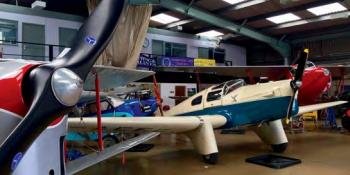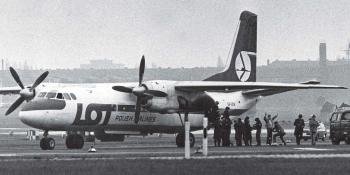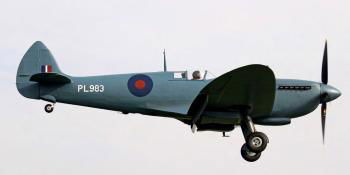The sole surviving example of Finland’s only indigenous production fighter, the VL Myrsky — its name meaning ‘storm’ — is well on the way to becoming a unique museum exhibit in its homeland
WORKSHOP

Then the chairman of Finland’s national defence committee, Field Marshal Baron Carl Gustaf Mannerheim realised in late 1938 that war could break out in Europe at any time. With hostilities in mind, he recommended that Finland should purchase military aircraft from abroad as soon as possible. It had acquired seven Fokker D.XXIs in 1937 and the licence-production of 35 more was in progress.
The Finnish Air Force, or Ilmavoimat, began its search for new fighter aircraft the following winter. Around that time, the possibility of domestic fighter production arose. Factors included the lower cost involved when compared with licence-building the Fokker D.XXI. Another driver was the promising prototype of the Pyry fighter trainer produced by Finland’s state aircraft factory, the Valtion lentokonetehdas (VL), which made its maiden flight on 29 March 1939. Some days later the VL received a call to tender for the proposed domestic fighter. It worked day and night on the project during April and May. In all, five alternative concepts were put forward.
The Finnish defence council decided to establish a new fighter squadron on 6 June 1939. Its aircraft would be purchased from abroad. The specification was very demanding — only the Heinkel He 112, Messerschmitt Bf 109, Supermarine Spitfire, Seversky EP-1 and all five domestic fighter alternatives met it. But none of the foreign types were available to Finland.




On 8 June 1939, the defence ministry ordered the indigenous fighter design from the VL. The specification demanded a 540km/h (335mph) top speed, a climb time to 6,000m (19,685ft) of not more than seven minutes and a landing speed not exceeding 115km/h (71mph). The armament was four 7.7mm (0.3in) machine guns and the engine a 1,060hp Bristol Taurus III, subsequently changed to the 1,100hp Pratt & Whitney R-1830-S3C3-G Twin Wasp due to imposition of a British embargo.
The Winter War with the Soviet Union temporarily halted the design of the new fighter, now called the VL Myrsky. However, the prototype was ordered on 20 December 1940 and serial MY-1 flew for the first time on 23 December 1941. Two weeks later the VL learned that Finland could buy Twin Wasp engines from German ‘war booty’ holdings in France. The available version was the 1,050hp R-1830-SC3-G. Development of the Myrsky prototype accelerated.
The Ilmavoimat’s fighter squadrons were in quite dire straits in the summer of 1942. Their best asset was the Brewster B-239. Germany had sold only obsolete captured French fighters to Finland: 24 Morane-Saulnier MS406s and 29 Curtiss Hawk 75As. The only way to ensure fighter deliveries seemed to be domestic production. The air force thus ordered three pre-production Myrsky Is on 30 May 1942 and 47 series production Myrsky IIs on 18 August, well before delivery of the Ilmavoimat’s first Bf 109 in March 1943.
The pre-production Myrskys arrived during the summer of 1943. They were soon destroyed: serial MY-2 when it ran out of fuel, MY-3 because of aeroelastic flutter of the elevators and MY-4 due to aileron flutter caused by incorrect balancing. The first series production Myrsky was taken on strength on 23 December 1943, but deliveries were slow. When the Soviet Union started the Vyborg-Petrozavodsk offensive on 10 June 1944, only four Myrsky IIs had been supplied, and they were used as test aircraft. Although Germany delivered more powerful Bf 109Gs to Finland, the need for fighters was urgent.
Tiedustelulentolaivue 12 — TLeLv 12, or Reconnaissance Squadron 12 — became the Myrsky’s first user. Its transition from the Fokker D.XXI started at Tampere in July 1944 and continued at the squadron’s base at Mensuvaara. The Myrsky came into operational service on 17 August, but it only fought in a few aerial battles before the end of the Continuation War. Those engagements resulted in damage to two Soviet fighters, an La-5 and a Yak-9. A Myrsky detachment participated in the Lapland War but just 32 sorties were flown due to poor weather. Otherwise the Ilmavoimat was mostly grounded by order of the Allied Control Commission until August 1945.



After World War Two, the Myrsky II was used as an intermediate fighter trainer, bridging the gap between the VL Pyry and the Bf 109G. The Myrsky suffered many structural problems, especially in the wooden wing due to poorquality organic glues (casein) and lacquers. Furthermore, the undercarriage was weak, and the engine keen to overheat. On 9 May 1947, Capt Kauko Ikonen was killed in the crash of serial MY-28, causing all Myrskys to be grounded. The Paris peace treaty had, in any case, limited the number of combat aircraft Finland could possess to 60. At the time it had 100 Bf 109Gs, and all other fighters, such as the Myrsky, were abandoned. Between them, the 51 Myrskys amassed only 3,051 flying hours, prototype MY-1 notching up the most. Production took more than one million working hours, equating to some 10 per cent of the VL’s capacity in 1943-44.
The Myrskys were scrapped in 1952-53. Just one complete example, MY-16, survived at Kauhava air base. Along with some Hawk 75s and Bf 109s, it met its end during the summer of 1965. However, three steel tube Myrsky fuselage frames were found in Jämsä in the late 1970s. They had lain in the open for more than 25 years. Pete Virtanen bought them and donated them to the Ilmavoimat. They arrived at the Suomen Ilmavoimamuseo, the Finnish Air Force Museum, at Tikkakoski in the early 1980s. About 2,500 drawings had almost been burned in Halli, but they were rescued and taken to the Ilmavoimamuseo at the start of the 1990s. These two events, together with the will to recreate the missing link between the Fokker D.XXI and the VMT Pyörremyrsky — a subsequent Finnish-designed fighter of which just one example was built — enabled the restoration of the Myrsky II. The example in question is MY-14, one of the 11 Myrskys that flew for more than 100 hours.
The Ilmavoimamuseo, the Finnish Aviation Museum (Suomen ilmailumuseo) and the Finnish Aviation Museum Society unveiled the Myrsky project on 16 March 2013. However, both the Ilmavoimamuseo restoration team and its counterpart at the society, known as the Tuesday Club, were involved in other tasks and it was unclear how the Myrsky effort would be funded. On 23 April 2014, the Aviation Museum Society signed an agreement whereby the Finnish aerospace company Patria would provide financial and practical support. Completion was aimed for August 2019, 75 years after the Myrskys were taken into service.


The aircraft is being restored to static display condition. The division of work between the Tuesday Club and the Tikkakoski restoration team was based on their respective skills. The Tuesday Club concentrates on the wooden structures like the wing, including the landing gear. The Tikkakoski personnel look after the metal ones such as the fuselage, the engine and the weapons.
The Tuesday Club consists of some 50 volunteers who preserve, restore and rebuild aircraft and their parts in collaboration with the Suomen ilmailumuseo. It has several jobs on the go at any one time. MY-14 engages about 15 volunteers including the project manager Matti Patteri.
Production of the Myrsky’s wooden wing parts by the Tuesday Club began in August 2015. The wing has two box spars with three plywood waists. The flanges are made of pine and laminated birch veneer lumber. Due to the tapered configuration, there are a lot of ribs with different shapes. Since every rib is divided into three parts — the leading-edge, middle and trailing-edge elements — there are 75 different wing rib parts, and two of each are needed for the two wing halves. The wing ribs are constructed from birch veneer and strengthened with pine strips. The fuselage formers transform the box shape of the steel tube frame into a rounded shape, and have the same structure as the ribs. The structure of the ailerons, as well as the vertical and horizontal stabilisers, is the same as in the wing: wooden spars and ribs covered with plywood.
It took two years to make the wooden wing components. The rib blanks were cut from plywood using a laser belonging to Riihimäkibased ProLaser. Otherwise, the production process was mostly manual work. The original Myrsky II wing was one 11m (36.1ft)-long component. The project steering committee decided to divide the wing into two halves and bolt them together using three steel plates. This made production of the wing easier, and it will be simpler to move MY-14 in the museum. Assembly of the port wing half started on 17 October 2017. It was removed from the jig on 19 May 2018, allowing the starboard half to take its place. After that, the building of the wing halves continued simultaneously.
The lack of the original landing gear was a problem. Only a few parts have been preserved, and certain design drawings were missing too. Matti Patteri had to design the complex undercarriage partly by using existing drawings and some photos as a basis. Patria and its subcontractors helped a great deal by manufacturing the shock-absorbing struts, but many components were made by Patteri himself, with the help of Vantaa Vocational College. The landing gear will not be fully operational as some items are unavailable, but it will be possible to move it up and down.
The Tuesday Club concentrates on the wooden structures, and Tikkakoski on the metal ones
Before the wing halves can be covered with plywood, all the internal structures and fittings must be made. There are two racks for 100kg (220lb) bombs or 150-litre (33-gallon) drop tanks and they need pipework for compressed air and fuel, contained in the leading-edge structure. The trailing-edge structure takes in the ailerons, the flaps and three driving gears for the ailerons, flaps and undercarriage. A lot of technology in a small space!

Two original but damaged duralumin elevators have been preserved. They will be restored and fitted to MY-14, although this example was originally equipped with wooden elevators and rudder. Matti Patteri rebuilt the rudder at an early stage of the project. All the trim tabs are original.
Patteri has made all the necessary jigs as well as the moulds needed to produce items such as the NACA cowling, which consists of eight aluminium segments. Antero Flander of metalworking firm Flanco shaped the upper part of the cowling as well as the outer and inner sections of the air duct using moulds produced by Patteri. Teemu Lehtinen from GA Telesis Engine Service welded the parts together. Flander shaped the so-called ‘pot plate’, the front plate of the engine mounting, from steel sheets less than 1mm (0.04in) thick. The shaping of the aluminium wing root fairings will be one of his next jobs.
Some of the Myrsky’s aluminium parts were fashioned using the technique called pressure turning. The spinner is original but its mounting ring and rear panel were missing, as were the wheel well covers. These have all been turned out by Valo-Steel Mentanova using moulds furnished by Patteri.
The Ilmavoimamuseo is the sole aviation museum in Finland which has permanent aircraft preservation staff. Although the team has more expertise in metal aircraft, one of the four is a skilled carpenter. Conservator Harri Huopainen is one of the few professionals in Finnish museums trained in aircraft preservation.
The Myrsky II project started at Tikkakoski by disassembling the three fuselage frames and digitising the design drawings. The latter process was carried out with the aid of the Äänekoski Vocational College. Some 2,500 drawings are now saved in PDF and TIFF formats. The three fuselage frames consisted of many small parts. Further important items were found in storage with the Ilmavoimamuseo, the Suomen ilmailumuseo and the Hallinportti Aviation Museum at Halli. Collectors have donated or exchanged Myrsky components to help in the restoration.
The rebuild of Myrsky MY-14 is the biggest aircraft restoration project in Finnish history
MY-14’s fuselage frame has been sand-blasted and painted, after which assembly of the preserved or repaired parts could begin. The cockpit is fairly complete in terms of the dashboard, dials and equipment. The armour plating on the seat back is an original part used in a Fokker D.XXI, but the seat itself has been reproduced.
The retractable tailwheel has been repaired, and all its ancillary equipment preserved, repaired or reproduced and installed in the fuselage. The aluminium firewalls had mostly disappeared and needed to be replicated. A comparison between the remains of the firewalls and the design drawings showed that some feed-throughs had been closed, so new ones were opened.
The Myrsky’s armament consists of four VKT 12,70 LKk/42 heavy machine guns manufactured by the State Rifle Factory (Valtion Kivääritehdas, VKT). This gun is an illegal copy of the Belgian-built FN Browning M.1939 but differs in calibre, this being 12.7mm (0.5in) on the Finnish weapon rather than 13.2mm (0.52in). Sufficient guns have been found for the project and the case boxes preserved, but the cartridge boxes are missing. They will be reproduced, as will the fuel and oil tanks.
MY-14 will receive a 1,200hp R-1830-S1C3-G Twin Wasp engine from the air force museum’s collection. The unit was previously in a Douglas C-47. As used in the C-47, the engine has an exhaust collector ring, while the Myrsky engine has separate exhaust pipes with tapering ends in order to produce extra thrust. Rauno Pylväläinen of Patria Aviation welded the complex exhaust system in 340 working hours. Installation work on the fuselage formers and the frames for access panels is in progress. The original canopy has been repaired, and the Perspex glazing is currently going in.
The rebuild of MY-14 is the biggest aircraft restoration project in Finnish history. So far, the number of working hours spent on it has exceeded 20,000. However, it has gone over-budget, so donations are welcomed. The project has also been delayed — the new target for the Myrsky’s unveiling is the spring of 2021 when Patria, the successor of the old State Aircraft Factory, will celebrate its centenary. Before that, there remains a lot of work to be done by the Tuesday Club and the restoration team at Tikkakoski.
ACKNOWLEDGEMENTS:
The author thanks Erja Reinikainen and Jukka Raunio.
For more information and to make donations, visit vlmyrsky.fi




